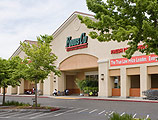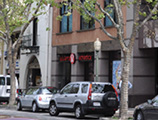When ChatGPT hit the street in late 2022, a close friend began amusing himself—and occasionally, me—by having it rewrite my essays. Sometimes, Bob would ask Chat to rework the piece in my voice (it acquires this capability by scraping one’s writings off the net), sometimes in its own disembodied style. He’d have it gin up different versions, some leaning scholarly, some more suited to The Daily Post. Those early digital forays went from the banal to the sophomoric, especially when it tried humor. I felt secure in this gig.
That was then. Rather than tell you what Chat can do now, I’ll show you. Here’s the experiment: I write a couple hundred words summarizing California retail, Bob feeds my paragraph to what he calls AI Johnny and directs it to rewrite two different versions, one academic, the other in my voice with an emphasis on humor. The two AI versions below—Chat wrote them in seconds—have not been edited. Here’s the trial:
(McNellis original paragraph) The truth universally held at Northern California’s most recent ICSC conference was that retail is back, that a supermarket-anchored center in a nicer suburb is the best possible CRE investment … as long as one doesn’t need to sell or finance it. Or, far worse, try to build one today. By all reports, these favored centers are so nearly full that leasing agents’ only complaint is a lack of inventory. Save a couple outliers, no new centers are under construction in California. This dearth of construction is blamed upon pre-Covid land prices, stubborn construction costs, high interest rates and uncertain values on completion. Prudent developers have reined in their edifice complexes and are satisfying themselves with the reworking of older centers, turning over “second gen” space to retailers eager for new locations. Or the developers are effectively working as partners with tenants such as Starbucks and Chick-fil-A acquiring parcels and building for them on a contractor-like basis. And it seems that all retailers, great and small, are struggling to find new sites, hard-pressed to make today’s economics work. Finally, while the values of second-tier shopping centers may have declined substantially, perhaps as much as 20 percent, those of the best centers—those supermarkets in high end, high-barriers-to-entry towns—have held their values and selling for as much as they did pre-pandemic.
(Chat Academic) The state of retail real estate in California today reflects a nuanced recovery, particularly in Northern California, as highlighted by insights from the most recent International Council of Shopping Centers (ICSC) conference. The consensus is that retail is resurging, with supermarket-anchored centers in affluent suburbs recognized as prime commercial real estate (CRE) investments. However, this optimism is tempered by significant challenges in selling, financing, or developing new projects under the current economic conditions.
Despite the high occupancy rates and demand for space in these preferred locations, leading to leasing agents lamenting the scarcity of inventory, new construction remains a rarity. This stagnation is attributed to a combination of high land costs lingering from pre-COVID times, persistent construction expenses, elevated interest rates, and the unpredictability of future property values.
In response to these hurdles, developers are adopting a more cautious approach, focusing on renovating older centers and recycling “second generation” spaces to meet retailer demand for new sites. This strategy not only mitigates development risks but also aligns with the market’s current dynamics, where finding suitable new locations proves challenging for retailers of all sizes due to the economic landscape.
Moreover, a subset of proactive developers is engaging directly with tenants like Starbucks and Chick-fil-A, acquiring land and constructing on their behalf in a contractor-like fashion. This partnership model illustrates the innovative methods being employed to navigate the complex retail real estate environment.
While second-tier shopping centers have seen their values decline, possibly by up to 20 percent, premium centers—especially those anchored by supermarkets in exclusive, high-entry-barrier locales—have maintained their valuations and continue to attract investment, comparable to pre-pandemic levels. This divergence underscores the varying fortunes within the sector, with top- tier properties resilient amidst broader market challenges.
(Chat Humorous McNellis): At the latest Northern California ICSC gig, the word on the street was that retail has risen from the dead, zombie apocalypse style. The golden child of commercial real estate investment? That would be your supermarket-anchored centers, nestled in the lap of suburbia’s elite. The catch? You’re golden as long as you don’t actually want to, you know, sell it, finance it, or heaven forbid, build one from scratch today. According to the grapevine, these coveted spots are so packed to the gills that leasing agents are practically weeping into their lattes over the sheer lack of space to lease. Except for a couple of brave souls, no one’s breaking ground on new centers in California, a situation as rare as a developer turning down a prime steak dinner.
Why the construction ghost town? Well, take your pick: land prices still stuck in their pre-Covid glory days, construction costs with more stickiness than a five-year-old’s hands, interest rates doing their best Everest impression, and the final cherry on top—finishing values as predictable as a teenager’s mood.
In a plot twist, prudent developers have dialed back their empire-building aspirations, focusing instead on giving a facelift to the oldies but goodies of the shopping center world. They’re spinning “second gen” spaces into gold, catering to retailers itching to set up shop in new digs. Some of the more gung-ho types are playing fairy godmother to the likes of Starbucks and Chick-fil-A, scooping up parcels and whipping up buildings faster than you can say “venti latte”.
Meanwhile, every retailer, from the giants to the mom-and-pops, is on a treasure hunt for new locations, navigating today’s economic minefield with all the enthusiasm of a dentist visit. And while the second-tier shopping centers might be experiencing a value slump—taking a dive of possibly 20 percent—the crème de la crème, those supermarket-anchored beauties in the high-rent districts, are holding onto their value like a cat to its last life, fetching pre-pandemic prices that would make even a Silicon Valley startup blush.
Both of these AI essays are pretty damn good, both are accurate, while the second struggles, like every writer, with humor. It seems AI has gone from the sixth grade to graduate school in the last 16 months. Where it will be in 16 years? Contrasting the flip phone of 2008 with today’s smart phone might give us a clue. As if the poor journalists weren’t already embattled.






















